Toshiba Excite 7.7 Tablet Review: AMOLED in a Fun Size
by Dustin Sklavos on August 29, 2012 2:01 PM ESTDisplay
Evaluating the Toshiba Excite 7.7's display has turned out to be more difficult than anticipated, due in no small part to the AMOLED panel used. That difficulty is exacerbated by what Toshiba calls their "AutoBrite" technology. This is a fundamental issue that has been brought up in other reviews of the Excite 7.7 that I've read, and it could very easily be a dealbreaker.
Depending on what's displayed on the Excite 7.7, the screen will dynamically brighten or dim. This isn't the usual ambient light sensor brightness control, this has to do with the content itself, and unfortunately it can get distracting. I suspect it's an "extra mile" to try and optimize what's already a beautiful AMOLED display, but in practice even scrolling through a Facebook page can become slightly annoying when the display pops up a bit, then dims a bit depending on how much white is on what you're looking at. If you're looking at content that's a bit more contrasty and tends towards darker hues more, the display becomes brighter to compensate.
There is no way that I can find to turn this off.

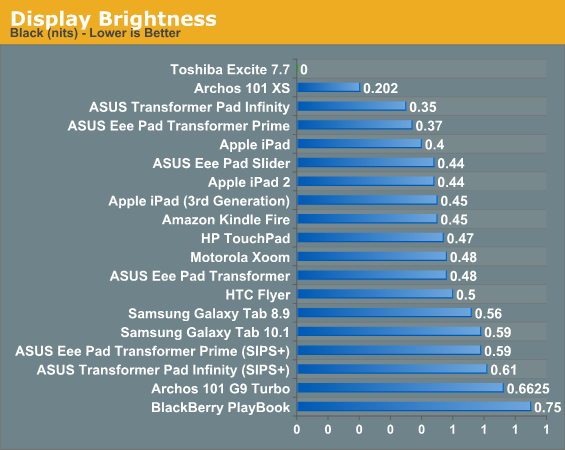
The black level is bulletproof, but I'm ambivalent on the white level. I measured it with the same hardware I use to measure notebook displays, but 175 nits seems extremely low and that's only exacerbated by Toshiba's own dynamic brightness modulation. When I look at the display, it's definitely not 175 nits; eyeballing it I'd say maximum brightness is easily past 300 nits.
With all that said, it's hard not to be wowed by the display. AMOLED technology produces the deepest blacks you're going to get in any kind of portable display, and the colors are equally vibrant and impressive. Even with the brightness adjustments going on, I personally think it's still more desirable than even an IPS display, but your mileage may vary.
Performance
NVIDIA's Tegra 3's performance is already pretty much a known quantity, but it's still impressive to see Tegra 3 stretching its legs in a tablet this small.
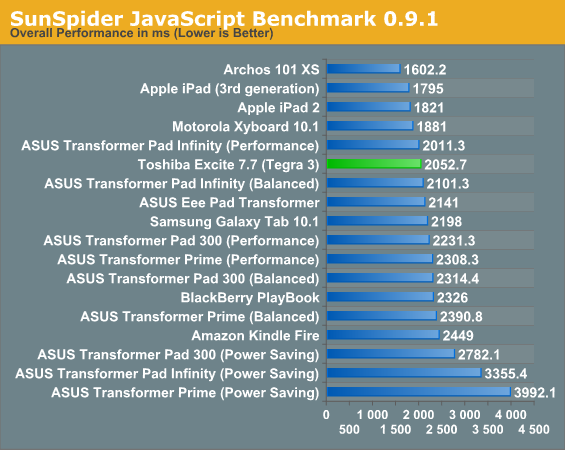
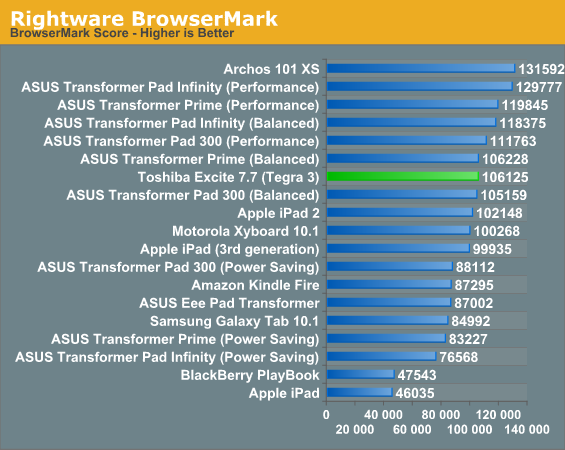
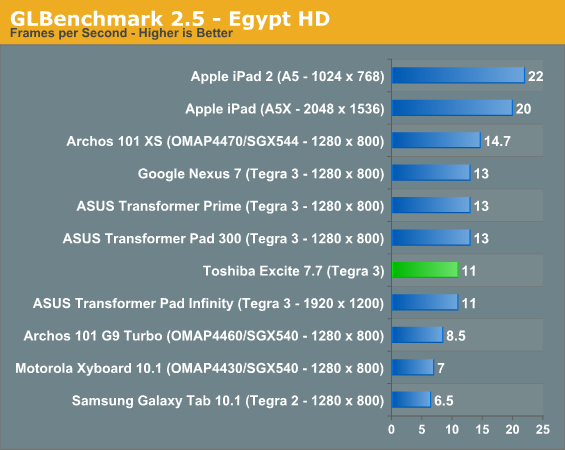
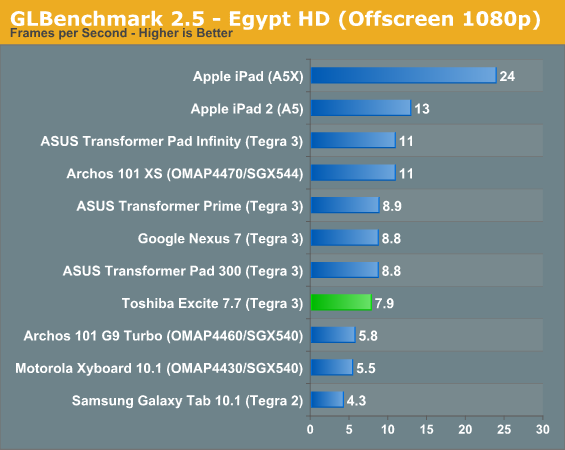

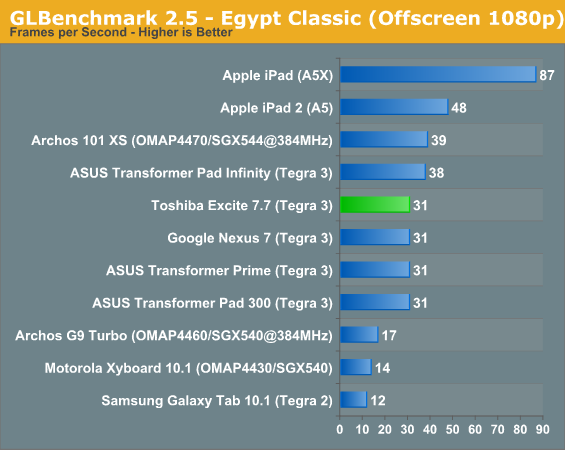
Performance isn't out of the park, but it's definitely competitive with other, larger tablets. You're definitely not making any sacrifices for the form factor here, the Excite 7.7's about as fast as any other Tegra 3-powered tablet out there.










50 Comments
View All Comments
fmcjw - Thursday, August 30, 2012 - link
I think constructive feedback is more helpful than your "just don't read it" attitude.The thing is, anything not written by Brian or Anand is pretty low standard stuff.
Disclaimers in a review are just verbose excuses for laziness or substandard content. If Brian did this review, in the comparison table in the "Storage" row, it won't just have 16GB or 8GB, but 16GB, 16GB+µSD, 16GB+µSDXC, etc.
solinear - Thursday, August 30, 2012 - link
Honestly, there are too many reviews for some of these devices. As for the review quality - I don't think it's a bad review, but it's definitely not enthusiastic either way. They're not going "OMG, this is a bad device" or "OMG, this rocks"... the review is going "Um... I had to do this review, but I hate the OS and really just want to go back to using my Windows Phone and wait for Win8 tablets to come out". I might as well go to MacAddict expecting a fair review of Win8 and Android tablets as reading this one.For tablets and phones, I'd rather see a page long "highlights" review unless it's a review of an item that is seriously cool. Then once a quarter, see a more thorough review. Seeing the stats for all those devices in every single darned review for a tablet gets really old fast.
A nice quarterly spreadsheet that summarizes up the performance, memory, etc... of all the devices with their prices would be nice. Then I can come in here, look at the device, read the review of the various features and see if there are any deal breakers and make an informed purchase.
jiffylube1024 - Wednesday, August 29, 2012 - link
I think the AMOLED (not SAMOLED+?) display alone makes this tablet interesting. It would be interesting to see this thing in person and compare it to the Nexus 7.At 349g, it's basically the same weight as the N7 (340g) and you get a 20.7% screen area increase, which is not too shabby.
This tablet's got a 5mp rear camera and 2mp front camera - better than the N7's single 0.3 mp front camera (although cameras on tablets, aside from their usage in Skype and other video chatting programs, have always seemed unnecessary to me).
It's interesting (and unfortunate) to note that there's a proprietary charger for this device; HP, Blackberry and Google had no problems making micro USB chargers; why can't everyone else?
---
The pricing for this Toshiba tablet does leave something to be desired; even in the $399-429 price range, clearly the 16GB Nexus 7 at $249 is a better buy.
Does this Toshiba tablet even come with Android 4.1? The Nexus, as a Google flagship, will be one of the first devices to get subsequent Android updates in a timely fashion. Bit players like these are not at all guaranteed to be updated.
nafhan - Thursday, August 30, 2012 - link
"although cameras on tablets, aside from their usage in Skype and other video chatting programs, have always seemed unnecessary to me"I completely agree with this statement.... which is why I was somewhat shocked when I went to an aquarium a few weeks ago and saw quite a few people walking around taking pictures with iPads. To me, this makes no sense, but that doesn't mean it doesn't happen.
Origin64 - Thursday, August 30, 2012 - link
Tablets in general are about as interesting as a funeral for someone I didn't know. Everybody's getting all emotional and I can't seem to care.But seriously, there just isn't much innovation in tablet-land right now. We can expect something new when win8 hits in a few months, and significant android price-drops after that. The focus will shift from being as fast as possible to being as cheap as possible while remaining competitive performance-wise. ARM just can't keep up to an i5, so why even bother to try?
The reviewer also raises an interesting point in that he thinks Android isn't perfect for tablets. Too few people have commented on what I also see as careless GUI design in some tablets. On phones it's simple, you've got notifications at the top and buttons down below. Same for the Nexus 7 (at least in portrait) The way the buttons and notifications are placed on this tablet just seems less intuitive to me.
The icons also appear too small, especially on this one. A 6x6 grid on 7"?
pandemonium - Thursday, August 30, 2012 - link
Because reviews should be full of sparkly vampires, pop-tart rainbow fliers, and lots of campy one-liners?medi01 - Saturday, September 1, 2012 - link
This reads as a funeral because of, cough, level of "journalizm" at anand, cough...AMOLED screen doesn't even get color gamut benchmarks eh? GL benchmark is all we care about? Seriously?
Article image is showing GREY screen, seriously?
You suck guys...
Jenaii - Wednesday, May 1, 2013 - link
that is right, the tablet market is targeting high performance tablet but that doesn't mean this tablet is out you may check the further review @ http://toshiba-tablet.com/Jenaii - Wednesday, May 1, 2013 - link
that is right, the tablet market is targeting high performance tablet but that doesn't mean this tablet is out you may check the further review @ http://toshiba-tablet.com/guidryp - Wednesday, August 29, 2012 - link
OLED screens are good on power until they display bright screen colors, especially white, when they draw more than LCDs.I suspect the dynamic control is really about keeping power usage down. They brighter the screen colors, the more power it draws and the more dimming that kicks in to curtail that power draw.
If it was just about aesthetics, it would probably be easy to disable.
I wonder if the Samsung OLED tablet with this screen does the same thing?